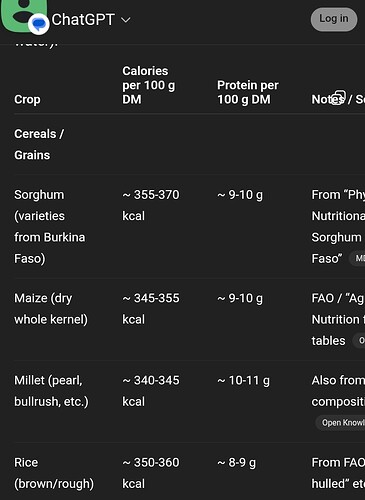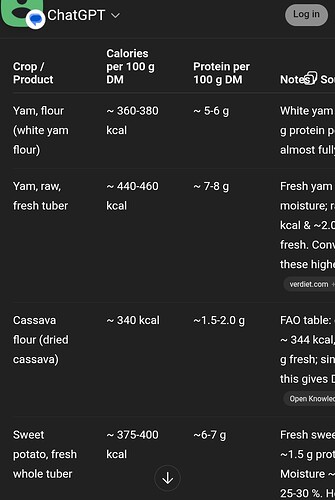I am interested in advising farmers on the best crop for nutrition and profitabliity in the dry areas of Africa. I have just returned from a visit to an area that seems to primarily prefer Sorghum but can also grow a variety of other crops such as Maize and possibly Amaranth. The resources I am finding via Duck Duck Go are not comprehensive and rather inconsistent. We are considering Maize and upland rice in future projects. Does any one have a trustworthy source of information about calories per 100 g of cereal as a resource? Thank you. relevant link 1relevant link 2link 3link 4
Hi Jeff,
if you’re looking for nutrition, than variety is more important than which kind of grain. I watched a documentary recently that claimed you should aim for twenty different kinds of food per week (!) for a balanced diet.
So we advise our visitors to plant as many different crops as they can manage (beside their “main” or “cash” crop). That also helps climate resilience.
Grains and legumes need to be consumed together to get all the essential amino acids (protein).
from
ADAPTATION AND SELECTION OF CROP VARIETIES FOR HOT ARID CLIMATE OF RAJASTHAN
“Sorghum and pearl millet are traditionally grown as rainfed crops mostly in environments characterized by a combination of the above listed stress factors, which become too marginal and unproductive for maize. Sorghum is a drought tolerant species, and pearl millet is even more drought tolerant with higher water use efficiency than sorghum. Similarly, pearl millet is even more salt tolerant than sorghum and is the second most salinity tolerant major cereal after barley. Pearl millet is better adapted to dry nutrient deficient soils and is thus cultivated under extreme harsh conditions of high temperature, low erratic rainfall and on soils with poor water holding capacity. It also has strong deep root system and short life cycle and can grow rapidly when moisture is available. As a result, it can survive and reliably produce small quantity of grain where mean annual precipitation is as low as 250 mm as compared to minimum water requirement of 400 mm for sorghum and 500-600 mm for maize. India is the largest producer of pearl millet, both in terms of area (9.3 m ha) and production (7.97 m t). Though a large number of pearl millet hybrids and some open pollinated varieties have been released for cultivation in arid regions, genetic differences in maturity and drought tolerance make some cultivars more suitable for dry regions. Early maturing cultivars escape terminal drought, making these more suitable for regions having extreme arid conditions, like western Rajasthan, parts of Gujarat and Haryana. Besides pearl millet, legumes are also cultivated in the arid western Rajasthan. These are moth bean (Vigna aconitifolius), mung bean (Vigna radiate), cluster bean (Cyamopsis tetragonoloba), horse gram (Macrotyloma uniflorum) and cowpea (Vigna unguiculata). Of these moth bean, guar and horse gram are highly drought tolerant and a number of early maturing varieties for cultivation in the arid regions have been identified.”
Hi Jeff,
I asked a former ECHO board member who is a registered dietitian and she recommended the following which includes one of the relevant links you already mentioned:
I like to use the USDA FoodData Central website. This site allows a search of several large USDA databases and the Foundation Foods database provides information on the number of samples and analytical methods used. I encourage anyone interested in comparing foods to look at the number of samples the table information is based on as well as the variation between samples. To use the USDA databases you just type the name of the food. The web page will tell you which of the databases the food can be found in. I recommend accessing it on a laptop, especially at first. If a food is not in the USDA database, the International Network of Food Data Systems (INFOODS) also has downloadable tables of the nutrient content of foods for some parts of the world (for example West Africa).
For a broad view of food composition resources available around the world and access to training materials that help to close the ‘knowledge gap’ concerning nutrition, the ECHOcommunity collection on Food Composition may also be helpful.
I am surprised that everyone is so focused on the nutrition side of the question and not the profitability. We need to know more about the rainfall, irrigation possibilities, water harvesting possibilities, slope, etc. Sounds like you might have quite a bit of rainfall if you are considering upland rice and maize. What about vegetables or other specialty crops? Do you have a market for them then you/they should consider producing them. Do you have a demonstration farm? Is that why you are using the term “we”? I think all the grains are nutritious (some more than others but there are and it is a whole lot more important what you supplement with the grains. Here growing vegetables and eating the #2s and things that don’t have the highest market value such as outer leaves of cabbage and the cabbage remains (grated) will get you ahead financially and also taking things to the market and bringing home values that are not selling well and therefore the prices are low. At first that might mean bringing home #2s. I do agree with another respondent that a mix of grains is much better because there are all kinds of factors that come into play with any one cereal such as tannins and phytic acid that are antinutritional when consumed as a larger percentage of the diet and different grains have different nutritional components. However, you are miles ahead by focusing on profit and Christian worldview in being motivated by the Great Commission and maximal blessing to others. That will lead to an excellence standard in time management and investment that will result in an abundant life and eventually dying with satisfaction and eternal rewards. You will become more discipline with your diet and exercise and time efficiency. Also consider that agroforestry and water harvesting may allow one to get into higher value crops with the same amount of rainfall. Mulch, human urine, green manures (even brown materials when you use human urine) in the planting hole, partial managed or dappled shade or tree canopy management systems that provide shade in the afternoon and during the dry season. I have systems for maximizing the use agroforestry if you are interested. Just email me at janzen200@yahoo.com. These are new systems that I have developed based on my orchard management background.
Hi Jeff,
Depending upon the exact location there are likely to be a few options. Local food plants (plants that are known to grow in the region) are best as they are suited to their environment and will better withstand pest and disease pressure. Local food plants are also often higher in key nutrients. There are SO MANY better options than maize. Food Plant Solutions (who I represent) specialise at creating educational resources that identify highly nutritious local food plants. Email us at info@foodplantsolutions.org https://foodplantsolutions.org/
I understand about sorghum and millet being helpful to feed families in dry lands. When conservation agriculture is applied, more variety becomes possible. I shared the research in my links attached because there seems to be no clear information. That is a discussion in and of itself, but the ‘bottom line’ is, would sorghum eaters be eager to grow maize if they knew it had greater nutritional benefit? Likewise, if upland rice is an option, what can a family expect if they take that risk to change their behavior? We are already asking a lot of them to stop burning and keep the goats from eating the blanket of fertility God has made. I want to advise them with good knowledge and I agree with you all about the temptation to aim for cash crops and decrease variety thereby. No one can serve 20 masters in the area of expertise on home grown meals no matter how well we prescribe that. I feel responsible for my part to advise well. Does anyone have resources that state the caloric value of the cereal crops in a uniform manner? Thank you.
welcome to tanzania i will prvide you land and we can make a good research for good market oscarsangawe7@gmail.com
Hey, that’s what I found real quick on chat gpt, is that what you were after?
For nutritional content comparisons I really like feedipedia - it’s really help for grains and forages/feeds.
I think you’ll find the calories per 100g dry matter not that different. What will vary will be the yield you can actually get in a given location and with a given crop and hence the calories you can actually produce per hectare.
A 2 ton maize crop will yield alot more calories than a 800 kg millet crop…
It’s hard to get a good millet crop that will give 2 tons/ ha in the Sahel - it would be much easier to do that with maize if you had the rainfall. So while the calorie content of maize isn’t much different from millet - if you were irrigating and fertilizing well the yield potential for maize would be much higher.
I say if you were irrigating because generally they prefer millets and sorghums in more arid places because they have good water use efficiency and are draught tolerant - so you aim lower but at least you get a crop and yes, they have higher protein content but many prefer quantity and profitability to healthiness when it comes to food.
Thank you. We have just gotten a report of upland rice harvest in this area so that will be a crop that may be important. I like what you are saying about the calorie production per hectare, given the climatic conditions. I would aim to encourage production without irrigating, although a pfumvudza plot seems manageable if a family can access a drip kit… I will have to look more deeply at the chatgpt info before I say more. But thanks so much, very timely!


